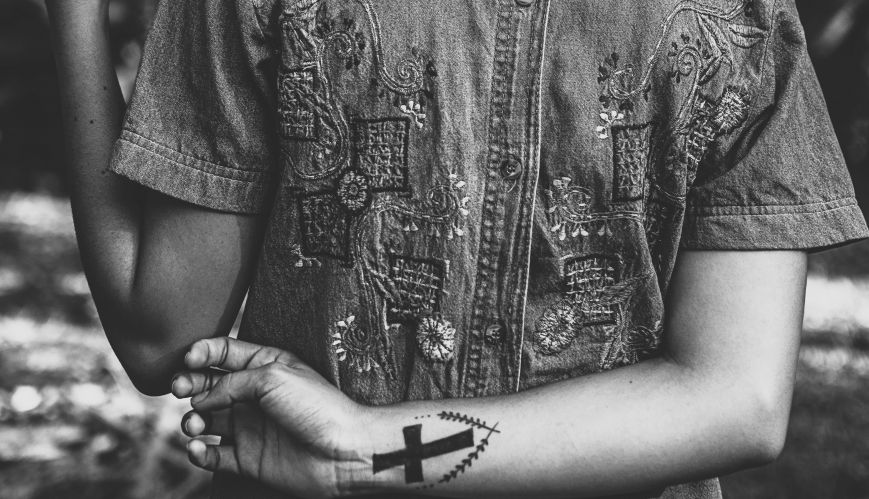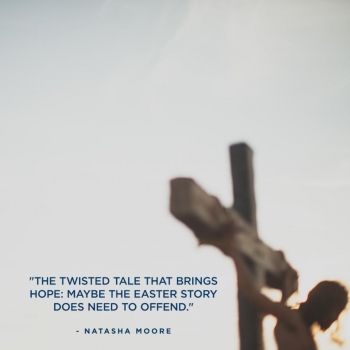The twisted tale that brings hope

The twisted tale that brings hope
30 March 2018
Photo:Richard Jaimes
A few years ago, a short-lived burst of hand-wringing (and not a little mirth) met the announcement that a survey conducted at a shopping centre in the United Kingdom indicated that 20 per cent of children thought Jesus Christ played football for Chelsea.
Privately, I have my doubts about the methodological robustness of that survey. Still, polls show pretty consistently that the Great Australian (or British or American) Public have trouble telling their Scripture from their Shakespeare. But however little the holy book of Christians is known in mainstream culture, the central image of the faith remains universally recognisable: from the Red Cross to the crucifix worn around necks or tattooed on biceps and wrists the world over.
Periodically, these symbols create a bit of kerfuffle in secular Western countries: nurses or flight attendants go to court to defend their right to wear one in the workplace, and win or lose (mostly lose, it seems). But the concern that the combination of a horizontal with a vertical line might cause offence is, for most 21st century people, a relatively abstract one. The true offensiveness of the cross is mostly lost on us in a culture where its function as an object of reverence for so long obscured its inherent gruesomeness. 
The gospel accounts of the death of Jesus strike a modern reader who knows anything of the process of crucifixion as staggeringly understated: “There they crucified him.” Crucifixion was designed to be especially painful, gory, and public. The ancient reader would have known all that was implied: the nails, 13cm-18cm long, driven through bone and nerve; the nakedness (glossed over in most religious art); the cruel tension between the need to breathe and the intense pain of doing so; the agonising slowness of death by exposure, asphyxiation, and shock, which could take up to three days.
Those who had seen crucifixions were in no doubt about the offensiveness – the sheer absurdity – of the Christian claim that God himself had submitted to such an ordeal. And it seems a strange, even sinister, story to set at the heart of your own story, as Christians do. It seems strange, even sinister, to wear near your heart or ink on your skin the execution device of a long-crumbled empire – worse, one that some regimes still use today.
Perhaps the closest we come now to that more visceral feeling of offence is the atheist accusation that the cross of Jesus represents an act of cosmic child abuse – God the Father sacrificing his own son to appease his own thundering wrath against humanity. This, they ask, this twisted tale lies at the foundations of Western culture? What’s wrong with you people?
And yet it’s plain, surely, that something is terribly wrong with us – with all of us. You don’t have to read the news for long to figure that out. The Easter story is a dark one. It matches our story, the darkness we see in the world, and (if we look honestly) in the recesses of our own hearts.
And if there is something terribly wrong with us, a more upbeat, sanitised story is not going to help us. Our real problems are not going to be addressed by something less gritty and devastating than the problems themselves. If God has, after all, come and taken our darkness into himself, the film of that book is not going to be PG-rated.
But Easter is also the most hope-filled of stories: sacrificial love, and glorious resurrection. The English writer and theologian, G.K. Chesterton, wrote of his confusion, as a young man, hearing the many and varied accusations flung at the Christian faith. People called it a doormat religion, or else the mother of wars; it offered a universal ethic or was nothing but monstrous superstition. Chesterton came to see this apparent contradiction as a testament to its authenticity: “Suppose we heard an unknown man spoken of by many men. Suppose we were puzzled to hear that some men said he was too tall and some too short; some objected to his fatness, some lamented his leanness; some thought him too dark, and some too fair. One explanation ... would be that he might be an odd shape. But there is another explanation. He might be the right shape.”
The Christian story is a very odd shape. With its sharp corners and unexpected softness, it still rubs plenty of people the wrong way. And if it’s merely a myth of questionable morality, then so it should. But if it captures something profoundly true about our strange world – where the terrible darkness of human nature and the unfathomable worth of human life coexist in agonising tension – then giving offence may still be exactly what we’d expect it to do.
Natasha Moore is Research Fellow at the Centre for Public Christianity. This article first appeared in The Spectator Australia.